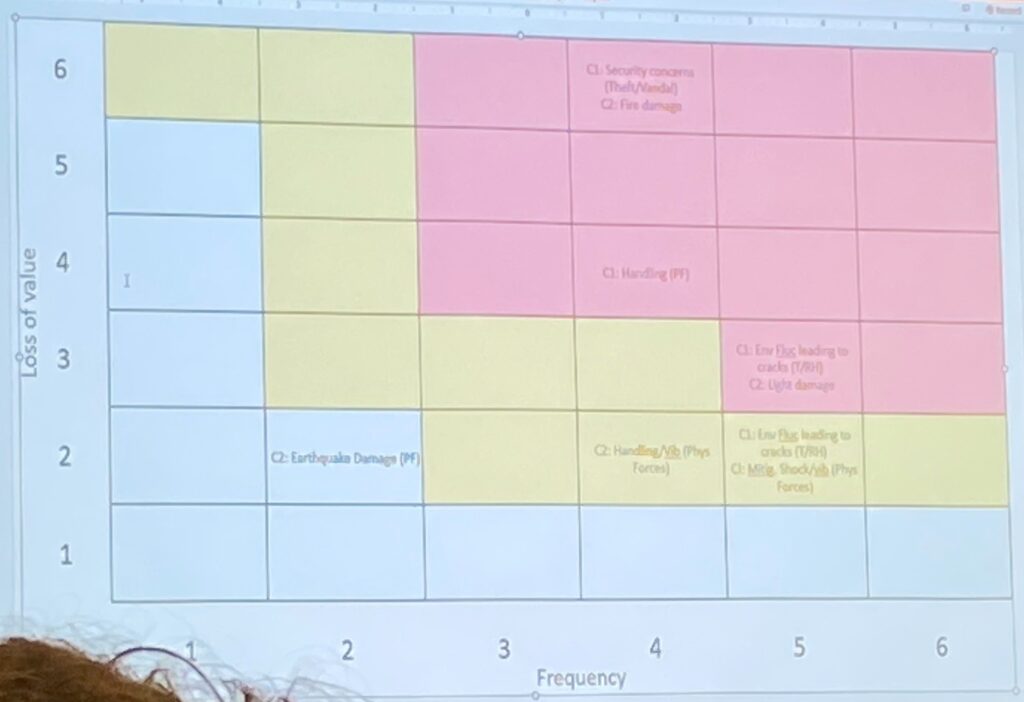The theme of the ERC was The Future of Tomorrow and there was understandably a focus on environmental sustainability. But alongside environmental issues there were also themes about economic sustainability, and making practical, pragmatic decisions based on assessing risk. I went to talks on data and digital developments in the sector which discussed more efficient ways of working. Two of these presentations are detailed below:
5th November 2022: Evaluating risks, monitoring and analyzing data of art in transit, Part 1
Cecilia Winter, Getty Conservation Institute, Los Angeles & Vincent Beltran, Getty Conservation Institute, Los Angeles
This workshop was facilitated by colleagues from the Getty Conservation Institute as part of their Managing Collections Environment Initiative. This initiative focusses on using scientific research to practically and pragmatically resolve issues related to collections environments, particularly in consideration of current sector trends which are moving away from narrow temperature and RH parameters for both environmental and economic sustainability.
A scenario was given to us to investigate as a group. We were asked to highlight the risks and say what mitigating factors we would implement to reduce these risks. The scenario involved lending a fragile panel painting to a small museum in South America with a very unstable environment. For the most part, discussion was focussed on managing the temperature and humidity for the object in transit and in-situ as these were considered the biggest risks to the object.
As a group we then completed a risk assessment exercise where risk = frequency x loss of value
| Frequency | Loss of Value |
| 1. Extremely rare 2. Very rare 3. Rare 4. Possible 5. Frequent 6. Constant | 1. Trivial consequences (good, stable) 2. Minor consequences (acceptable, stable) 3. Significant consequences (fair, probably unstable) 4. Critical consequences (poor, unstable) 5. Severe consequences (serious, severely damaged) 6. Catastrophic consequences (beyond corrective action) |
The risks we highlighted were then plotted on a graph where the frequency of the event was on the x axis and the potential loss of value on the y. Interestingly, when we completed the exercise, security (theft, vandalism) and fire concerns received the highest score, and therefore proposed a higher risk.

The conclusion was that you should consider spending less time worrying about the things in yellow, because they are less likely to happen, and if they do happen, the consequences may not be particularly bad. Whereas, you should spend more time concerned with the red issues (security and fire risks), because they are very likely to be catastrophic.
This was a helpful tool to help focus thoughts on managing risks to collections, particularly as resources become more limited.
Further details on the initiative’s work can be found below:
Managing Collection Environments Initiative (getty.edu)
Vibratory Impacts of Music/Transport on Museum Collections (flippingbook.com)
https://www.cs.unm.edu/~pgk/IVCDs14/minitufte.pdf
https://getty.app.box.com/folder/160540133696?s=b9l2f035wky2s4d5bwp8vnuo75h9uqhe
https://m.box.com/shared_item/https%3A%2F%2Fgetty.box.com%2Fs%2F1s9zhqlmrc8jiswzthjsfyobzek7j78r
HERIe: team meeting at the Getty Conservation Institute in Los Angeles (heritagescience.edu.pl)
HomeTitle – HERIe2 (mnk.pl) – HERIe is a digital decision-supporting platform providing remote access to data manipulation tools and to quantitative assessment of risks to heritage assets. The platform is organised in the framework of ten independent modules corresponding to ten agents of deterioration.
Free online Psychrometric Calculator (hvac-calculator.net)
4th November 2022: EODEM: The Exhibition Object Data Exchange Model
Rupert Shepherd, CIDOC Documentation Standards Working Group. Presented by Angela Kipp.
Museum Study Instructor Angela Kipp
What is EODEM? | Rupert Shepherd
Angela Kipp gave an engaging presentation about the EODEM (Exhibition Object Data Exchange Mode) project. This is a framework that will enable us to export object data from one collection management system and import the data into another collection management system at the press of a button, which will help to reduce the amount of data entry required for managing exhibitions.
As EODEM will use LIDO data, which is Lightweight Information Describing Objects LIDO overview – ICOM CIDOC -ICOM CIDOC – so it is just the basic collection information we should already have on our databases.
At the National Gallery in London, Rupert Shepherd estimates that in the worst-case scenario, their teams have spent an entire year over the last ten years entering incoming loan data into their system so the aim of this project is to save time.
Information on this exciting project and the survey and results can be found here: EODEM – ICOM CIDOC -ICOM CIDOC
Sarah Kavanagh
Registrar: Collection and Documentation, Collection Care, The British Museum

 Instagram
Instagram  LinkedIn
LinkedIn  Twitter
Twitter  My Account
My Account